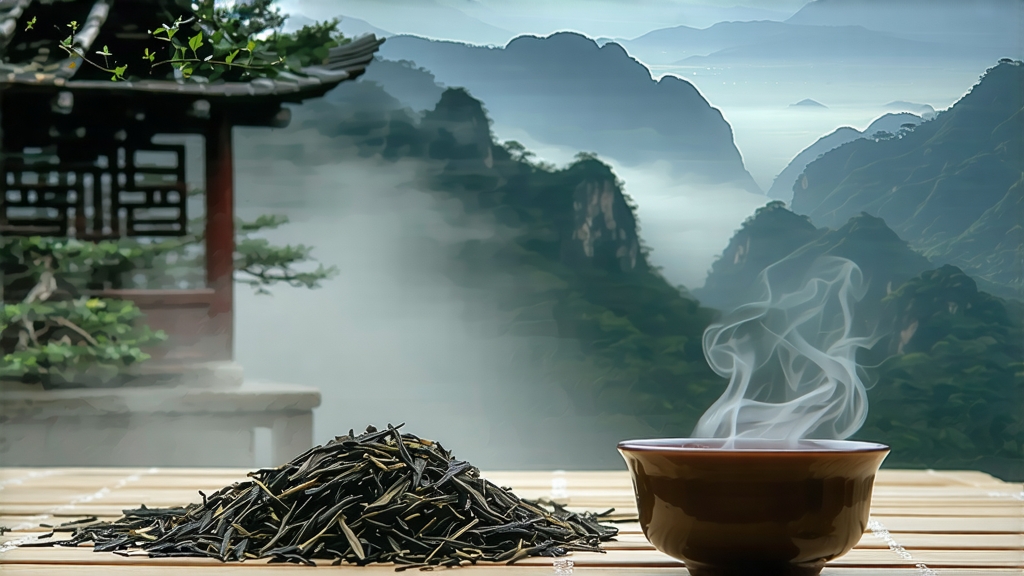
Ask most Westerners to name a Chinese black tea and “Lapsang Souchong” still rolls off the tongue with theatrical flair. Yet behind the smoky swagger lies a far more nuanced story: the first black tea ever created, born in the cool gorges of the Wuyi Mountains, traded along 17th-century river routes to Europe, and still hand-finished today over smouldering pine embers. This article walks international drinkers through that saga—history, leaf styles, craft, and cup—so the next infusion is less “campfire in a cup” and more “a sip of living Fujian heritage.”
-
From Song to Smoke: a 400-year timeline
Wuyi farmers were baking compressed green cakes for the Song court when Ming dynasty edicts suddenly banned powdered tea. Needing a faster way to oxidise and dry leaf before the mountain fog rolled back in, they allowed the leaves to redden overnight, then rushed them through a pine wood fire. The accidental smoke fixed the sugars, extended shelf life, and created a flavour so arresting that Dutch merchants paid double for it in 1604. By the late Qing, “Bohea Souchong” (the old port-name for Wuyi) had eclipsed green tea in London auctions, and the East India Company began smuggling cuttings to Assam, effectively seeding the entire Indian tea industry. -
Terroir: why Wuyi’s gorge mist matters
Tongmu village, perched at 27° N inside a national nature reserve, sits in a granite canyon where daytime heat drops 10 °C at night. The swing slows oxidation, thickens cell walls, and concentrates aromatic compounds. Wild tea bushes (Camellia sinensis var. sinensis, small-leaf) root directly into mineral-rich weathered rock, giving a natural cinnamon-like sweetness that balances later smoke. Only leaf picked within this 600 m corridor may be called “Zhengshan Xiaozhong”—literally “small-leaf from the original mountain,” the protected geographical indication that separates authentic Lapsang from commodity copies fired in distant factories. -
Leaf grades: not all smoke is equal
Traditional Zhengshan Xiaozhong is unsmoked first, then lightly scented; export-grade Lapsang is rolled after oxidation and heavily smoked. Recognise three tiers:
• Premium unsmoked (wu xun): charcoal-baked only, cocoa and longan notes, aimed at the Chinese gongfu market.
• Traditional pine-smoke (you xun): one-night cold smoke over resin-poor pinus massoniana, 28–32 °C, for eight hours; aroma lingers but does not dominate.
• Heavy smoke (export style): higher temperature, repeated firings, tarry fragrance designed to survive months at sea and milk in English teacups. -
Craft: the eight stages that marry fire and fragrance
a. Pluck: one bud, two leaves, 5–7 cm standard, picked before Grain Rain to keep tannins gentle.
b. Withering: trays set over chestnut charcoal, 30 °C for 6–8 h; moisture drops to 60 %.
c. Rolling: 45 min on bamboo mats, cell rupture 85 %, releasing catechins and sugars.
d. Oxidation: leaves rest in cedar-lined boxes, 24 °C, 85 % humidity, 3–4 h; leaf edge turns maroon, centre remains olive—signature “two-colour” strip.
e. First firing: hot wok, 200 °C, 2 min, kills enzymes, sets colour.
f. Smoke curing: pinewood is burned down to embers, transferred to a brick chamber; tea sits on upper racks while cool, aromatic smoke circulates. Artisans judge by nose: too short and the cup is hollow, too long and creosote masks honey.
g. Second firing: gentle charcoal bake, 80 °C, 30 min, stabilises moisture at 5 %.
h. Sorting: stalks and flakes removed by hand; only 60 % of original weight remains. -
Chemistry in your cup
Gas-chromatography studies show that pinewood contributes guaiacol, 4-methyl-guaiacol and syringol—compounds also found in whisky barrels—yielding clove